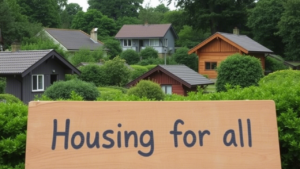Quick Guides for Policy Makers
Introduction
The concept of “adequate housing” has emerged as a cornerstone of global policy frameworks aimed at addressing the urgent needs of low-income communities. As urbanization accelerates, the lack of affordable, secure housing has become a critical barrier to equitable development, pushing millions into informal settlements and urban slums. Recognized as a human right by the United Nations, adequate housing ensures access to safe, habitable, and culturally appropriate living conditions. These Quick Guides serve as a concise yet comprehensive resource for policymakers, urban planners, and advocates seeking actionable strategies to tackle housing deficits, improve existing informal settlements, and prevent future slums. By synthesizing key concepts, challenges, and solutions, this guide provides a roadmap for city-wide interventions that prioritize inclusivity and sustainability.


Section 1: Following Quick Guides for Adequate Housing and Urban Slums
Key Concepts in Low-Income Housing
Adequate housing, as defined by the UN Committee on Economic, Social and Cultural Rights, encompasses not only physical safety but also security of tenure, accessibility, cultural adequacy, and the availability of services like water, sanitation, and energy. For low-income populations, however, these standards are often unmet due to systemic inequities. Urban slums—characterized by overcrowding, lack of infrastructure, and insecure land tenure—house nearly one billion people globally, according to UN-Habitat. These settlements are a direct result of rapid urbanization outpacing housing supply, exclusionary land policies, and poverty.
Drivers of the Housing Crisis
- Population Growth and Urbanization: Over 68% of the global population is projected to live in urban areas by 2050, straining existing housing infrastructure.
- Income Inequality: Limited financial resources prevent low-income households from accessing formal housing markets.
- Policy Gaps: Weak governance, insufficient land allocation, and neglect of informal settlements exacerbate the crisis.
- Climate Vulnerability: Informal dwellings often lack resilience to disasters, compounding risks from extreme weather.
The interplay of these factors creates a cycle of marginalization, where slum dwellers face health hazards, social exclusion, and limited economic mobility. Addressing this requires a multi-faceted approach that integrates policy reform, community engagement, and investment.
Section 2: Strategies for Addressing Existing Slums through Quick Guides
Tenure Security and Legal Recognition
Secure land tenure is foundational to slum upgrading. Governments must formalize land rights through titling programs or community land trusts, reducing displacement risks. For example, Brazil’s Família Program provided land regularization for over 2 million families, fostering long-term stability.
Infrastructure and Service Provision
Improving access to basic services like water, electricity, and sanitation is critical. Low-cost, scalable solutions, such as decentralized wastewater systems or solar-powered lighting, can be implemented through partnerships with NGOs and local governments. Community-led initiatives, like Kenya’s Mukuru Slum Upgrading Project, demonstrate how participatory planning can enhance service delivery.
Community Empowerment and Participation
Slum residents are often excluded from decision-making processes. Inclusive governance models, such as India’s Slum Rehabilitation Authority , empower communities to co-design solutions. Training programs for informal workers in construction or waste management also create livelihood opportunities, reducing poverty-driven housing pressures.
Preventing Future Slums: Proactive Planning
To avoid creating new slums, cities must prioritize affordable housing in urban plans. Inclusive zoning laws, such as those in Medellín, Colombia, reserve land for social housing while incentivizing mixed-income developments. Additionally, microfinance schemes and subsidies for incremental construction enable low-income households to build homes gradually.
Section 3: City-Wide Solutions for Affordable Housing
Policy Frameworks for Scalability
City-wide approaches require integrated policies that align housing targets with broader urban development goals. Key considerations include:
- Land Use Planning : Identifying underutilized land for affordable housing and avoiding urban sprawl.
- Public-Private Partnerships (PPPs) : Leveraging private investment through tax incentives or risk-sharing agreements.
- Regulatory Reforms : Streamlining permits for social housing and penalizing speculative land hoarding.
Financing Mechanisms
Funding remains a challenge. Innovative models like municipal bonds, impact investing, and international grants can bridge gaps. For instance, South Africa’s RDP Housing Program has built millions of homes using a mix of government subsidies and community contributions.
Sustainability and Climate Resilience
Affordable housing must incorporate eco-friendly designs to mitigate climate impacts. Low-cost green technologies, such as rainwater harvesting systems or energy-efficient materials, reduce long-term costs while enhancing resilience.
Monitoring and Accountability
Transparent monitoring frameworks, such as data dashboards tracking housing targets, ensure accountability. Civil society organizations like Habitat for Humanity play a vital role in advocating for policy adherence and reporting progress toward SDG 11 (Sustainable Cities).
Conclusion
This Quick Guides underscores the urgency of addressing inadequate housing through holistic, city-wide strategies. By securing tenure, upgrading infrastructure, empowering communities, and fostering sustainable policies, cities can transform slums into thriving neighbourhoods while preventing new crises. Policymakers must view housing not as a standalone issue but as a catalyst for social equity and urban resilience. As global urban populations grow, the lessons outlined here offer a blueprint for equitable development that leaves no one behind.
External Links for Further Reading
- UN-Habitat’s Slum Upgrading Guidelines
- UN-Habitat’s Global Urban Observatory provides data and case studies on slum conditions and urban policies.
- World Bank Urban Development Resources
- Explore the World Bank’s Urban Development Strategy at World Bank Urban Hub for financing and planning insights.
- Habitat for Humanity’s Affordable Housing Toolkit
- Access practical guides for community-driven housing solutions at Habitat for Humanity .
- UN Sustainable Development Goal 11
- Learn about global targets for sustainable cities at SDG 11 .
- International Alliance of Inhabitants
- Advocacy resources on housing rights and tenant protection at AIH .
By engaging with these resources, stakeholders can deepen their understanding and implement evidence-based solutions tailored to local contexts.
